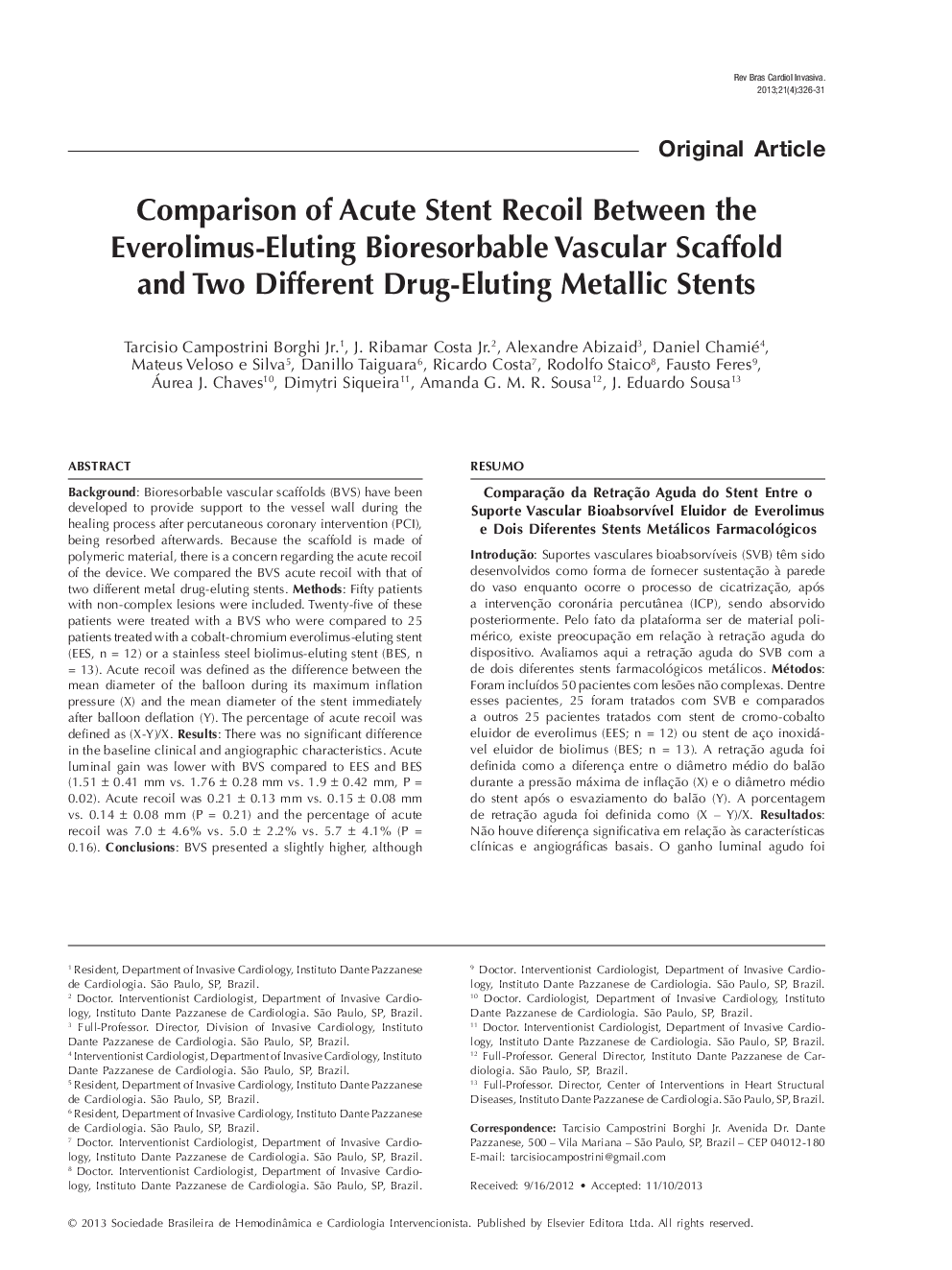| کد مقاله | کد نشریه | سال انتشار | مقاله انگلیسی | نسخه تمام متن |
|---|---|---|---|---|
| 3011747 | 1181769 | 2013 | 6 صفحه PDF | دانلود رایگان |

ABSTRACTBackgroundBioresorbable vascular scaffolds (BVS) have been developed to provide support to the vessel wall during the healing process after percutaneous coronary intervention (PCI), being resorbed afterwards. Because the scaffold is made of polymeric material, there is a concern regarding the acute recoil of the device. We compared the BVS acute recoil with that of two different metal drug-eluting stents.MethodsFifty patients with non-complex lesions were included. Twenty-five of these patients were treated with a BVS who were compared to 25 patients treated with a cobalt-chromium everolimus-eluting stent (EES, n = 12) or a stainless steel biolimus-eluting stent (BES, n = 13). Acute recoil was defined as the difference between the mean diameter of the balloon during its maximum inflation pressure (X) and the mean diameter of the stent immediately after balloon deflation (Y). The percentage of acute recoil was defined as (X-Y)/X.ResultsThere was no significant difference in the baseline clinical and angiographic characteristics. Acute luminal gain was lower with BVS compared to EES and BES (1.51 ± 0.41 mm vs. 1.76 ± 0.28 mm vs. 1.9 ± 0.42 mm, P = 0.02). Acute recoil was 0.21 ± 0.13 mm vs. 0.15 ± 0.08 mm vs. 0.14 ± 0.08 mm (P = 0.21) and the percentage of acute recoil was 7.0 ± 4.6% vs. 5.0 ± 2.2% vs. 5.7 ± 4.1% (P = 0.16).ConclusionsBVS presented a slightly higher, although not significant, acute recoil than the two second-generation metallic drug-eluting stents.
RESUMOComparação da Retração Aguda doStent Entre o Suporte Vascular Bioabsorvível Eluidor de Everolimus e Dois Diferentes Stents Metálicos FarmacológicosIntroduçãoSuportes vasculares bioabsorvíveis (SVB) têm sido desenvolvidos como forma de fornecer sustentação à parede do vaso enquanto ocorre o processo de cicatrização, após a intervenção coronária percutânea (ICP), sendo absorvido posteriormente. Pelo fato da plataforma ser de material polimérico, existe preocupação em relação à retração aguda do dispositivo. Avaliamos aqui a retração aguda do SVB com a de dois diferentes stents farmacológicos metálicos.MétodosForam incluídos 50 pacientes com lesões não complexas. Dentre esses pacientes, 25 foram tratados com SVB e comparados a outros 25 pacientes tratados com stent de cromo-cobalto eluidor de everolimus (EES; n = 12) ou stent de aço inoxidável eluidor de biolimus (BES; n = 13). A retração aguda foi definida como a diferença entre o diâmetro médio do balão durante a pressão máxima de inflação (X) e o diâmetro médio do stent após o esvaziamento do balão (Y). A porcentagem de retração aguda foi definida como (X – Y)/X.ResultadosNão houve diferença significativa em relação às características clínicas e angiográficas basais. O ganho luminal agudo foi menor com o SVB comparado ao EES e ao BES (1,51 ± 0,41 mm vs. 1,76 ± 0,28 mm vs. 1,9 ± 0,42 mm; P = 0,02). A retração aguda foi de 0,21 ± 0,13 mm vs. 0,15 ± 0,08 mm vs. 0,14 ± 0,08 mm (P = 0,21), e o porcentual de retração aguda foi de 7,0 ± 4,6% vs. 5,0 ± 2,2% vs. 5,7 ± 4,1% (P = 0,16).ConclusõesO SVB demonstrou ter retração aguda ligeiramente maior, embora não significativa, que os stents metálicos farmacológicos de segunda geração.
Journal: Revista Brasileira de Cardiologia Invasiva (English Edition) - Volume 21, Issue 4, 2013, Pages 326–331